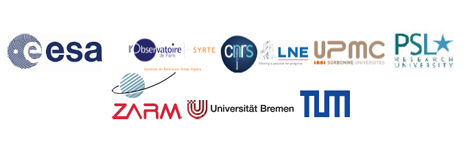GREAT: Galileo gravitational Redshift test with Eccentric
sATellites
Experiment Description

Einstein's Theory of General Relativity (GR) predicts that time flows differently for two clocks that have a relative speed and are placed in different gravitational potentials. It is therefore possible to test GR by comparing the frequencies of two clock, in a so-called gravitational redshift test. As several alternative theories of gravitation predict violations of this effect – e.g. in attempts to unify GR and quantum theory – experimental constraints are of paramount importance. The best test to date was performed with the Gravity Probe A (GP-A) experiment in 1976 with an uncertainty of 1.4 × 10−4.
The GREAT (Galileo gravitational Redshift test with Eccentric sATellites) experiment proposes to use the on-board atomic clocks on the Galileo-201 and -202 satellites to test the gravitational redshift. Their unintended elliptic orbits induce periodic modulation of the gravitational redshift, while their very good clocks stability allows us to measure this periodic modulation very accurately. It has been shown that assuming realistic noise and systematic effects, it should be possible to improve on the GP-A limit down to an uncertainty around (3−4)×10−5 after one year of integration of Galileo-201 data1.
However, good control of systematic effects will be essential to calculate robust limits on the parameters of the GR violation. In this context, the proposed dedicated Satellite Laser Ranging measurements should allow us to make significant progress in disentangling the desired red-shift signals from systematics due to the clock, orbital modeling, target signatures, and tracking system specific errors. This will require the best tracking coverage of the two Galileo satellites’ orbits in space and in time.
NOTE:
For the GREAT GR tests, two parallel research activities have been launched by the European Space Agency, led respectively by the following two institutions:
- ZARM Center of Applied Space Technology and Microgravity, at Bremen University in Germany;
- SYRTE laboratory - Systèmes de Référence Temps-Espace – of CNRS / Paris Observatory – PSL Research University /UPMC – Sorbonne Universités in France, both specialists in fundamental physics research.
1
Station Instructions
The unplanned eccentric orbit of Galileo-201 and -202 provides a unique opportunity to study the behavior of on-board clocks and the gravitational redshift predicted by General Relativity. The Galileo-201 and -202 satellites, the first two Fully Operational Capability (FOC) satellites, were launched on August 22, 2014. Due to technical problems with the launch, these satellites remain in an elliptical orbit, which is not useful for the Galileo operations.
An elliptical orbit induces a periodic modulation of the gravitational redshift at the orbital frequency. Since these spacecraft have atomic clocks with good stability, a test of the variation of the redshift can be performed and an accumulated relativistic effect can be determined over the long term. SLR data are required to characterize the orbital radial errors, which are highly correlated to clock errors in IGS orbit solutions. Galileo-201 is equipped with a Passive Hydrogen Maser clock (PHM); Galileo-202 has a Rubidium clock. The orbits of these satellites have a 20 days repeat cycle, 37 revolutions and are separated by 180 degrees in mean anomaly.
Colleagues with the Galileo mission have proposed a one-year, ESA funded experiment, GREAT (Galileo gravitational Redshift Experiment with eccentric sATellites) during which the SLR will provide periods of intensive tracking on Galileo-201. The GRGS ILRS Analysis Center will analyze the SLR data, and compare it with the IGS orbits produced for the IGS Multi-GNSS Experiment (MGEX) campaign. Thus the experiment will also provide an opportunity to improve the calibration of the IGS orbits and the SLR data. Dr. Pacôme Delva gave a presentation and paper on the experiment at the 2015 ILRS Technical Workshop in Matera, Italy.
The stations in the ILRS network are asked to support this experiment as follows:
- The GREAT experiment will start on May 1, 2016.
- Stations are asked to concentrate observations during one week per month, the first 7 days of each month, over a period of one year. These 7-day periods will allow the SLR network to intensively sample the orbit on a monthly basis and still encompass the different weekly operating schedules from one station to another.
- Although the two satellites are set at their specified priorities for the entire year of the experiment, stations are asked to track the target satellite (Galileo-201) more intensively during the one week monthly period. Galileo-202 will be a secondary or backup target used if there are issues with the -201 satellite itself.
- Stations should observe each pass, sampling data from the beginning to the end, with one or two normal points about every 50 minutes.
- Normal points are a maximum of 5 minutes in duration.
This is a very exciting experiment and the ILRS is pleased to play an important role. We realize that schedules are full but we hope the stations in the ILRS network will support the GREAT experiment to the best of their ability. We encourage your station to participate.
Summary of Scientific Results from the GREAT Experiment
Related Information:
- Description of experiment from 2015 ILRS Technical Workshop (presentation | paper)
- GREAT experiment summary
- GREAT experiment tracking statistics
Recent News
(1) Data Handling File
(2) Eccentricity Files
(3) SLRF2020 Positions & Velocities
Read more
The ILRS station tracking priority survey results can be found here.
Read more...




